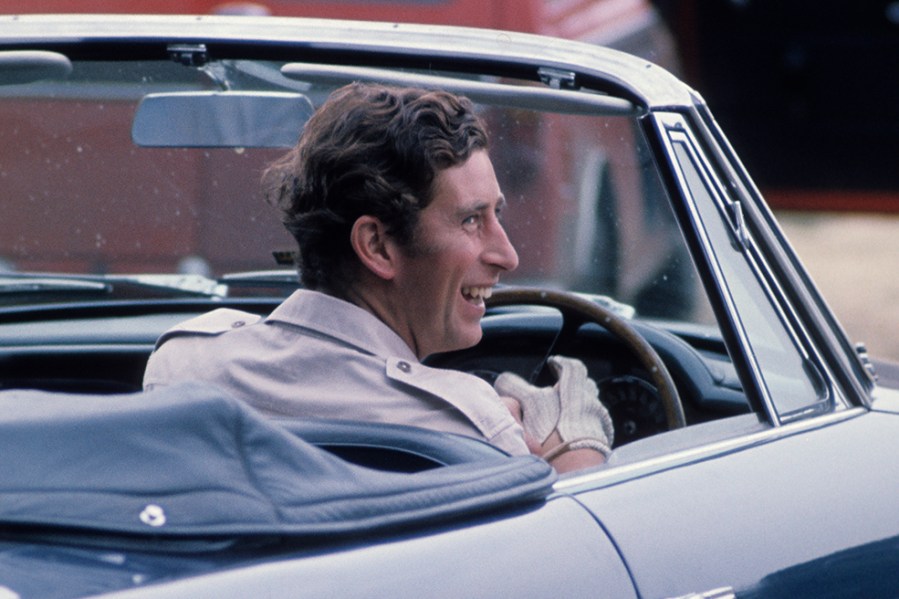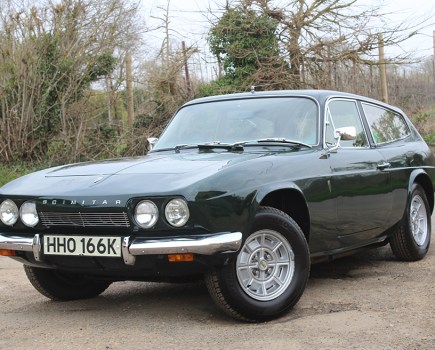With the Coronation of King Charles III taking centre stage, we look back at the history of some key classic cars with significant Royal connections
Words: Simon Jackson Main image: Anwar Hussein/Getty Images
With the Coronation of King Charles III now almost upon us, the world is preparing to officially welcome the arrival of a new King. The pomp and circumstance on the big day is sure to impress, with pageantry aplenty involving horses, carriages and – above all – cars.
The occasion naturally presented Classics World with an opportunity to delve into the various Royal classics from today and years gone by; ranging from those cars used for formal state occasions to the more mundane transport employed by the Royals, and their extended family, in everyday life. From bespoke Bentleys to stunning sports cars, hatchbacks to estates, the Royal Household has a rich history with classic and modern classic cars – as we will discover.
The Late Queen’s Daimlers
Prior to the Coronation of Queen II, Daimler had held the Royal warrant for motor vehicles, and it’s believed that the late Queen took delivery of her first Daimler saloon, a Series 3 Daimler Double Six, in October 1984. That car – B432 VYO – was intended for use by Her Majesty as her personal car; transport for local engagements and those where she didn’t wish to have a high profile. Replaced in 1991, it continued to serve as part of the Royal fleet for several years until it was returned to Jaguar with 29,000 miles recorded. It was sold in 2009 by Bonham’s Auctions for £12,363.
A second Daimler Double Six S3 – J52 PWK – was used by HRH between 1991 and 1995. It was purchased in 2008 by its current owner, with its history not known until a Heritage Certificate was applied for –a welcome surprise for its new owner! At the time it wore a different registration mark, but the DVLA was able to reunite the car with its original plate having sought permission from the palace itself. This car was driven by our very own Paul Wager in 2013 for sister title, Classic Car Mart.
A Daimler Six LWB followed – N52 VKV, finished in Edinburgh Green, this time not a Double Six, but a Daimler Six saloon based on the then-new LWB X300 bodyshell. Little seems to be known about this car; only a couple of photographs stand as evidence of what happened to it after its Royal role. Records show it has not been scrapped, exported, or had a registration change, but the number plate is not recognised by the DVLA for tax or MoT purposes, either, and it shows as having zero previous owners. It is therefore a reasonable assumption to suggest that it remains with the Royal Family.
A Daimler V8, registration S916 OGW, came next, but, again, little is known about it. Sold by the Jaguar Daimler Heritage Trust, there is speculation that the car might previously have worn the registration S34 MNV, as photographs exist of the former monarch with a Daimler of this registration. Once again, it was the entry-level engine specified with the long wheelbase shell. The car was sold by Bonhams as part of a large sale of Jaguar collection cars in 2009, when it was acquired by Royal memorabilia collector and former racing driver, Peter Ratcliffe, for £13,225. In 2010, he sold the car to a Japanese collector, and its whereabouts have not been known since.
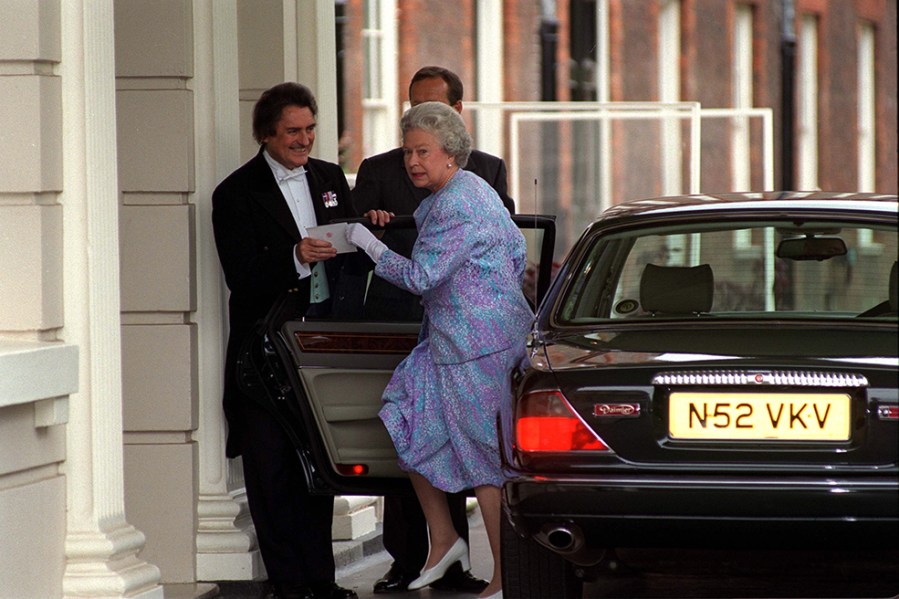
Queen Elizabeth II arriving at Clarence House for The Queen Mother’s 97th birthday in her Daimler Six LWB. (Photo by Tim Graham Photo Library via Getty Images)
Peter Ratcliffe was also responsible for the sale of another of Her Majesty’s former Daimlers – a 2001 Super V8 – Y694 CDU – which was sold by Jaguar at the same Bonhams sale in 2009 for £14,375. Once again, the colour was a dark green, and several photographs exist of Queen Elizabeth II driving this car during her four years of ownership. Ratcliffe advertised the car for sale in 2013, and it was eventually auctioned by specialist, Historics. This car is known to have been fitted with personal extras on behalf of Her Majesty; ranging from padded inserts for the rear door pockets to stop her dogs from sliding into them, to an extendable insert to the top of the front armrest designed to accommodate her handbag. In the back, twin window switches were fitted to each door in order that Her Majesty might control both windows from whichever side she chose to sit. Direct telephone lines to the Home Office and Downing Street were also fitted (since deactivated) alongside the usual panoply of blue emergency lighting. The car was subsequently sold again by H&H in 2017, reaching £43,700.
A second Daimler Super V8 – BK52 DLO – was ordered before the first car was returned to Jaguar. With the end of X308 production already stated, the order for this car came so late in the day that the final Super V8 had already been built. The Sapphire Blue example was therefore the exception to the rule that Royal Daimlers should be finished in Green alone. It covered 5000 miles while part of the Royal fleet, and today it is kept by Jaguar Heritage.
Finally, when the Daimler version of the X350 was launched in 2005, it should come as no surprise to learn that one of the first to be built was supplied to the Palace. Finished in Gavin Green, the Daimler Super Eight – BD05 VPP – is believed to still form part of the Royal vehicle collection.
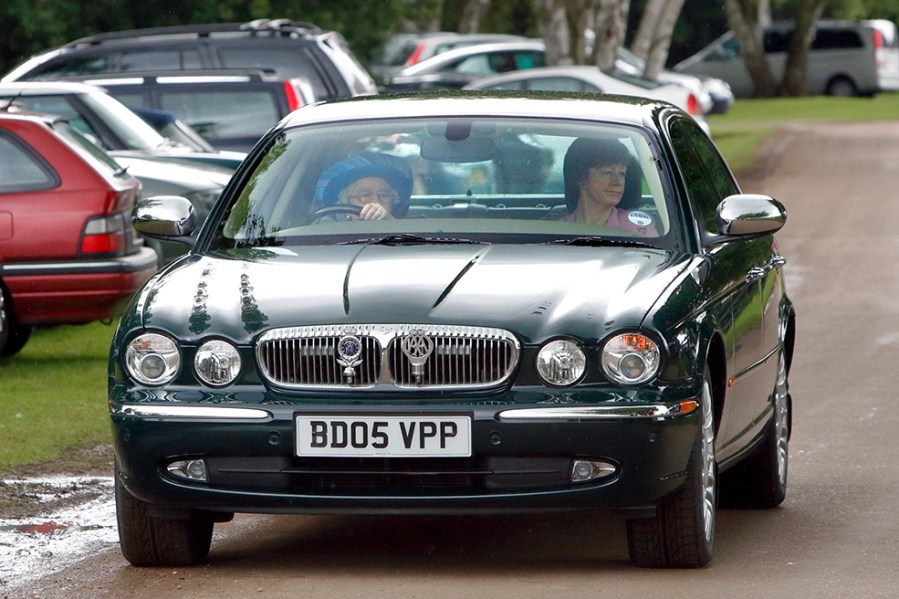
Queen Elizabeth II (accompanied by her police protection officer Carol Quirk) drives herself to The Credit Suisse Royal Windsor Cup Final at Guards Polo Club in 2007 in her Daimler Super Eight (Photo by Max Mumby/Indigo/Getty Images)
Corgi cars
Queen Elizabeth II was known for being an ardent motorist, with a particular penchant for large estate cars – suitable for transporting the Corgis, of course. The Queen began her association with Vauxhall – another Royal Warrant bearer – in 1961, when she was ordered a PA Cresta Friary Estate. As the name implies, the car was converted by Friary Motors of Basingstoke, an authorised coachbuilders with full factory backing and dealer support from Luton.
The PA Friary is the only Vauxhall to be displayed in the Sandringham Estate garage; it’s since been displayed at NEC Classic Motor Shows, and during her Platinum Jubilee celebrations. Since the PA Cresta, she also ran an F-type Victor estate, a PC Cresta estate with Prince Philip and a one-off Viceory Estate, and a Vectra C Elite 2.8 twin turbo, produced after much to-ing-and fro-ing between Luton and Opel in Rüsselsheim. A six-speed manual was specified, and the electric tailgate release was deleted to avoid the corgis escaping with ease. The Queen is also known to have enjoyed Rovers, including a P5B and at least one 827 Sterling.
In more recent times, she became known for her adoration for Jaguar X-type estates. It is believed that at least three such cars were built for her use, though it is possible that there were more given that they all wore her personal registration mark; PYN 1F. The registration has long been associated with Her Majesty’s load luggers – first seeing service on a Vauxhall Cresta estate in the late 1960s. Photographic evidence suggests that a Gavin Green pre-facelift X-Type estate was followed by a pair of Jaguar Racing Green facelift models – all are believed to have been 3.0 Sovereign specification.
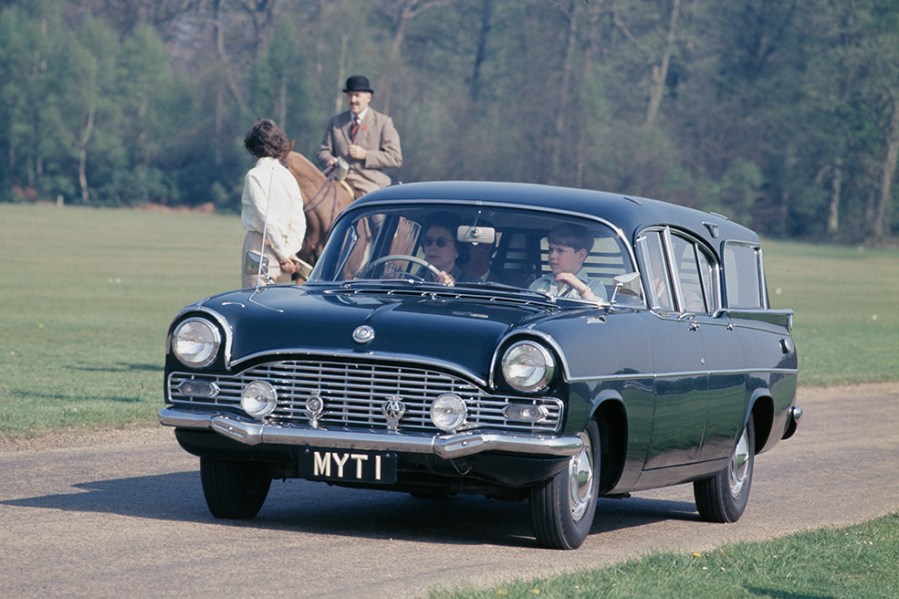
Queen Elizabeth II drives Prince Andrew to the Windsor Horse Trials in 1968 at wheel of a 1961 Vauxhall PA Cresta Friary Estate (Photo by George Freston/Fox Photos/Hulton Archive/Getty Images)
It is believed that the pre-facelift X-Type, known to have been in her possession in 2006, did not directly replace her Daimler, rather it replaced the Vectra estate. Of the two facelift cars, one was sold in 2016 and it was reported that the new owners were not informed that the car they had bought had previously enjoyed Royal patronage.
PYN 1F was still registered to a 2009 Jaguar X-Type 3.0 Sovereign when Queen Elizabeth II passed away.
Following her passing, the Emerald Fire example with Barley leather interior was auctioned by Historics in November 2022, showing 72,544 miles. Anticipated to appeal as much to serious Jaguar collectors as Royalists, the auction lot sold for £39,200.
Perhaps fittingly, it was an XJ model – a specially commissioned ‘X351’ hearse – that took Elizabeth II to her final resting place, travelling between Wellington Arch and Windsor. Two independent coachbuilding firms made the hearse a reality from a stripped down XJ saloon – Premiere Sheet Metal in Nuneaton made the body while Wilcox Limousines in Wigan created and fitted the interior trim, exterior trim, and glazing.

Queen Elizabeth II in her Jaguar X-Type as she watches the Land Rover International Driving Grand Prix (Photo by Chris Jackson/Getty Images)
Land Rover love affair
It is no secret that Queen Elizabeth II was fond of Land Rovers, and she wasn’t alone. Prince Philip was an equally ardent fan, which led to him working in collaboration with the brand on a pair of modified examples for use at his own funeral in 2021. But, the Royal Family’s history with Land Rover can be traced all the way back to the model’s inception in 1948. The late Queen’s father, George VI, was presented with one of the earliest examples – chassis number R860101. He granted Land Rover its first held Royal Warrant in 1951, with pictures of the then Princess Elizabeth riding in Land Rovers from the same period underlining her lasting history with the brand.
Several unique Land Rovers accompanied Queen Elizabeth II and the Duke of Edinburgh on their six-month tour of the Commonwealth in 1953, travelling through Bermuda, Jamaica, Fiji and Australia.
Just this year, a Royal 1953 Land Rover Series I (86-inch chassis) went under the hammer via Silverstone Auctions. Supplied to the Royal family for use at Balmoral Castle, NXN 1 was the 11th example built that year, used exclusively by Queen Elizabeth II and Queen Elizabeth, The Queen Mother, Prince Phillip and Prince Charles until 1966. Re-registered as LXC 894D, it was purchased by a new owner who kept it until February 2023.
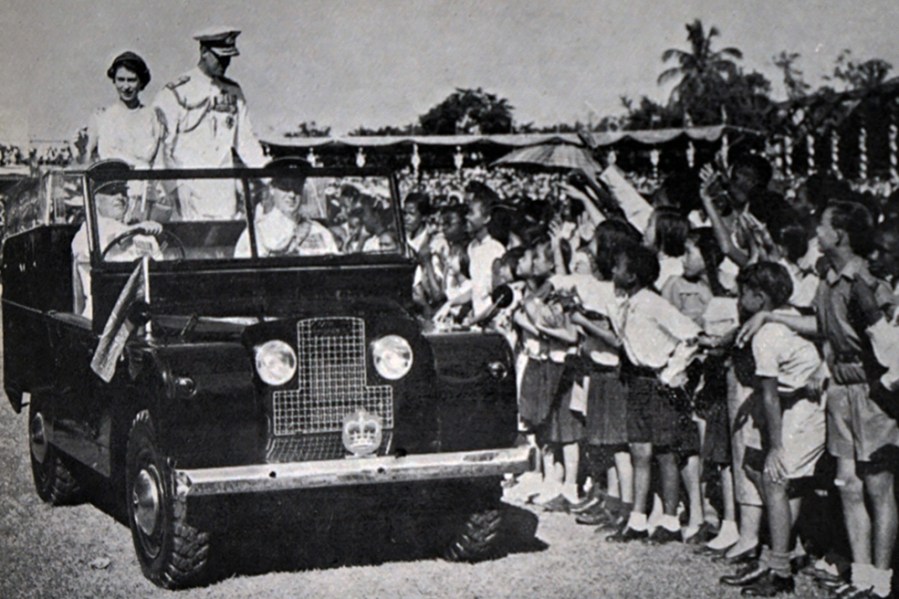
Queen Elizabeth II and Prince Philip in a Land Rover riding through Sabina Park, Kingston, Jamaica (Photo by Universal History Archive/Universal Images Group via Getty Images)
The utilitarian nature of Land Rovers fitted with the pastimes enjoyed by the Royals; outdoor pursuits like shooting and equestrian activities, so the cars were a regular sight at both Sandringham and Balmoral. Several were modified with small extras, bespoke touches unique to the Royal Family. For example, a Series III fitted with a lighting system allowing the late Queen to signal her driver to stop, and a 1980s One-Ten equipped with external handles to allow passengers to ride on its sidesteps.
One particular One-Ten V8, ordered in 1983, enjoyed 18 years’ service in Norfolk; special paint, a manual gearbox, an intercom system and grab handles lifted the specification past that of a standard long-wheelbase ‘Landie.’ Its replacement, a Defender 110 V8, was delivered as an automatic but then converted to manual at the request of the Royal household.
In the 1970s Range Rovers began to appear as part of the Royal household. Along with Jaguar, Land Rover was the only automotive manufacturer to hold all three Royal Warrants from the late Queen and the Duke of Edinburgh, and the-then Prince of Wales, Charles. Prince Philip famously picked up Barack and Michelle Obama in a Range Rover when they paid a visit to Windsor in 2016. In 2019, Philip was involved in an accident outside Sandringham, rolling a Freelander in a collision with another private vehicle on the public road outside. The incident is said to have somewhat dented his pride.
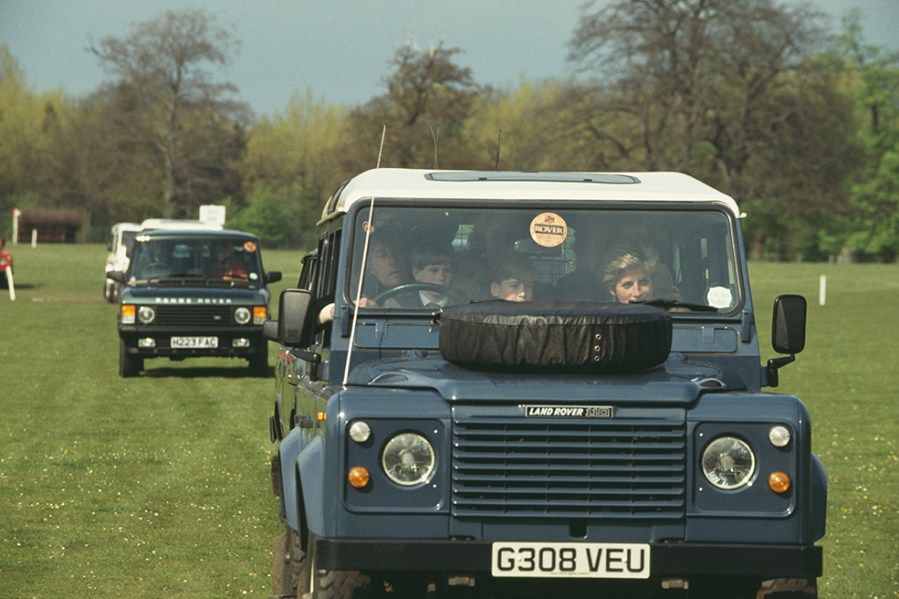
Diana, Princess of Wales takes her sons William and Harry to the Badminton Horse Trials in 1991 (Photo by Terry Fincher/Princess Diana Archive/Getty Images)
Royal Rolls-Royce and Bentley
Bespoke-bodied Royces were synonymous with Royal state visits, and the Phantom line carried out these duties perfectly. In her youth the former Queen, then Princess Elizabeth, owned two of the 18-car production run of Phantom IVs: her first, chassis ‘4AF2’ carried Mulliner coachwork, while the second, ‘4BP5’, wore Hooper bodywork. These Phantoms set a constant seen throughout the Queen’s reign, where she employed the highest performance variant of whatever car was in consideration, for public and private facing roles. Kept at the Royal Mews until 2002, HRH’s second Phantom IV was sold at auction by RM Sotheby’s in 2016, fetching £800,000.
In recognition of her Golden Jubilee in 1977 came a Phantom V. Carrying her heraldic shield (and a police blue light) it had a special, elongated Perspex glasshouse, taller than standard, with elevated rear seating so that the Queen could be better seen by the public outside. Her State Limousine featured a George and Dragon radiator cap and was the first Phantom V to receive a Silver Shadow II-specification 6.75-litre V8 and a GM 400 automatic gearbox. Having taken the new King, Charles III, from Buckingham Palace after the Queen’s death, this car also took part in the late Queen’s state funeral procession, carrying Prince George of Wales, Princess Charlotte of Wales and Catherine, Princess of Wales last September.
When the Royal Family’s fleet of cars needed updating in 2001, one of four Royal Warrant holders for the supply of vehicles, Bentley, was given the nod. Two State Limousine were designed and built for Royal use, in time for the former Queen’s Golden Jubilee tour in 2002. More presidential limo than State Limousine, the Abbey Panel bodied, Bentley Arnage-based creations were built in consultation with the former Duke of Edinburgh.
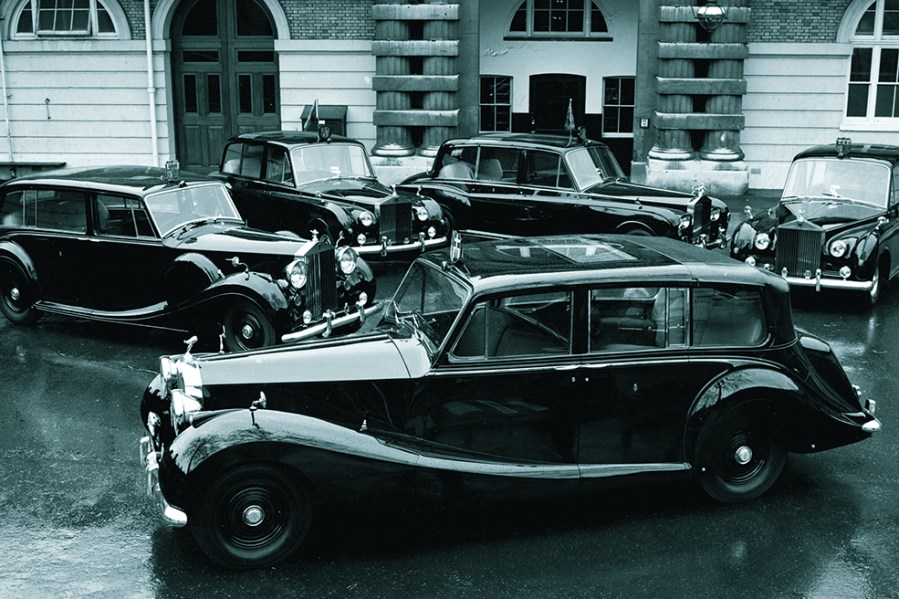
A selection of Royal Rolls-Royces at the Royal Mews (Image: Rolls-Royce)
Described as the ‘ultimate coachbuilt Bentley’, they were three feet longer, 10 inches taller, and six inches wider than a standard Arnage. They were also the first state conveyances to be armoured; special door sills allowed the Queen to stand up as she exited the vehicle. Mine resistant floors, rocket-proofed glass, Kevlar reinforced tyres and ventilation that could withstand a gas attack were features, too.
A more understated car would also be required for the Diamond Jubilee in 2012. Bentley’s Mulsanne would form the basis. In addition, the Royal Mews would call on Bentley to provide vehicles for visiting dignitaries, these offered by the Bentley Press and Special Vehicle Operations department. At the Race Retro Classic and Competition Car Sale conducted by Silverstone Auctions in February, one such Bentley Mulsanne with a royal history went under the hammer. The 2013 Dark Sapphire vehicle was described as having conducted “Royal Household Duties”, taking HRH Prince Charles to at least one official engagement. Presented in showroom condition, as you would expect, it had covered just 33,182 miles during its lifetime, but, on that occasion, it failed to find a new home.
The King and Aston Martin
The Royal association with Aston Martin dates back to the 1950s. In March 1954, a matter of months after the last Coronation, the then Duke of Edinburgh took delivery of a three-litre Lagonda – OXR 1. The new motor did not go unnoticed within the extended Royal family, and soon afterwards the Duke of Kent, a keen car enthusiast with a long association with motor racing, came into the possession of the 1955 Monte Carlo rally-winning DB2/4. And in April 1965 the Queen visited the Aston Martin factory in Buckinghamshire, where she was gifted a miniature recreation of James Bond’s DB5 from Goldfinger. The battery-powered car, built by 30 Aston Martin engineers over a period of two-and-a-half months, was capable of a top speed of 10mph and was handed to Prince Andrew. It can now be viewed at the Sandringham Museum. In later life Andrew acquired a full-size Aston Martin – a V8 Virage Volante.
Despite this, the Royal perhaps most associated with the Aston Martin brand is our new monarch; King Charles III. In 1967 the-then Prince Charles took delivery of an MGC GT – SGY 766F. He drove the Mineral Blue MG for more than 30 years before reportedly passing it along the succession line to Prince William.
But, MG is not the manufacturer we all associate with this HRH. Just after his 21st birthday in November 1969, Charles was gifted a Seychelles Blue Aston Martin DB6 MkII by his parents. His lifelong adoration for the brand was secured, so too, Aston Martin’s Royal Warrant. Being given one Aston Martin is indeed the stuff of dreams, but Charles has received two in his lifetime. In 1986, the-then Prince was gifted a V8 Vantage Volante from the Emir of Bahrain. Charles chose British Racing Green with mushroom inners, while deleting the side skits and a few other features – the ‘Prince of Wales specification’ was born. And it became popular, with owners either requesting the same spec from the manufacturer in period, or, in later years (even to this day) converting cars to match.

Charles driving his 1994 Aston Martin Virage Volante to play in the Dorchester Trophy charity polo match at Cirencester Park Polo Club in June 2005 (Photo by Max Mumby/Indigo/Getty Images)
Passing the passion down the generations, Charles received a miniature version of his V8 in 1987, much like the ride-on cars both he and Andrew had received as children, on this occasion to be used by Princes William and Harry. When the time came to replace the V8 Vantage Volante, Charles opted for a 1994 Virage Volante. He auctioned the older Aston Martin in December 1995, with the permission of the Emir of Bahrain, of course, the proceeds went to his own charity, the Prince’s Trust. At the Sotheby’s-run sale, it made £110,000.
Now, it is no secret that Charles is a passionate environmentalist, and this sat slightly at odds with his desire never to part with the DB6 he loved so dearly. In recent years, the car which he fondly refers to as the “old lady”, was sent back to Aston Martin headquarters for a refit. The end goal was to make it more environmentally friendly, either that or he would be forced to part with it. The Aston’s engine was subsequently modified to run on E85 bioethanol fuel, a by-product from wine manufacture and the fermentation created during cheese making. The car was famously used in 2011 by the new Duke and Duchess of Cambridge after their wedding reception.
Our new King has remained a staunch supporter of Aston Martin. In 2004, during a visit to the Gaydon production line, he gave a speech to the workforce, and is quoted as saying: “One of the reasons I have been a huge fan of Aston Martin for 34 years is because I have always recognised that it is a real work of art. I am devoted to my 34-year-old car, which I do love. It rattles a bit, like I do, but otherwise it has done nothing but give real pleasure and enjoyment all these years.”
Let’s also not forget that, as monarch, His Royal Highness no longer requires a driving licence.
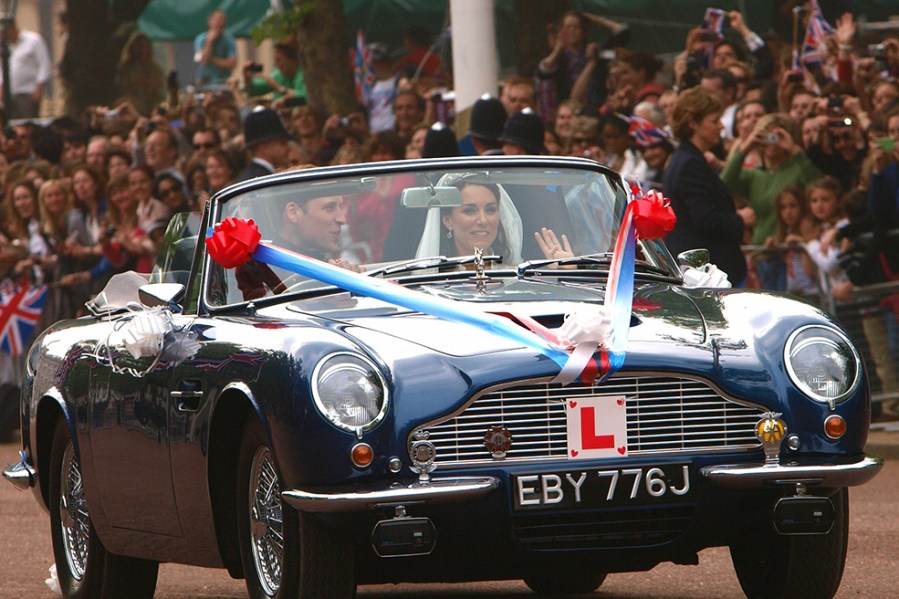
The newly married Duke and Duchess of Cambridge (now Prince and Princess of Wales) on The Mall in London in his father Prince Charles’ Aston Martin DB6 Volante in 2011 (Image by MAX NASH/AFP via Getty Images)
£6.3m: a collection fit for a king?
With his Coronation fast approaching, King Charles III’s private collection of cars has come under the microscope. In a recent investigation by The Guardian newspaper, his personal fleet was estimated at a value of £6.3 million. In its article, the publication sought to unravel the vehicles currently owned by Charles from those owned by the state, or on loan from manufacturers – and that’s no easy task. It identified 12 cars resident at Sandringham, and also visited the Royal Mews in Buckingham Palace to get a better understanding of the situation.
At the Mews it found a 1900 Daimler – the car that once belonged to Edward VII, and the 1950 Rolls-Royce Phantom IV that belonged to Charles’s parents, now valued at a cool £2.5m. This is the car that was used by the new King back in September when he stopped at the gates of Buckingham Palace to greet well-wishers following the former Queen’s passing. The 1977 Rolls-Royce Phantom VI, used by Princess Eugenie at her wedding in 2018, is also understood to have belonged to late Queen – a gift from the UK motor industry to mark her Silver Jubilee, now estimated to be worth £1.3m. While the 1962 Rolls-Royce Phantom V, purchased by the Queen Mother, is also assumed to now belong to King Charles.
At the family’s private estate, Sandringham in Norfolk, a former stable block houses a collection of cars which The Guardian collectively values at £1.8m. Amongst the most valuable here is a 1961 Rolls-Royce Phantom V, claimed to be worth £700,000 or more, last used as a state car in 2002. The 1970 Aston Martin DB6 Volante owned by Charles is also resident here, and it’s throught this could be worth at least £2m at auction.
The Guardian approached Buckingham Palace prior to the publication of its story, including a list of cars it considered to be private, but the palace refused to identify which specific cars in the mews were “owned by the sovereign in right of the crown” or “leased from the manufacturer.”
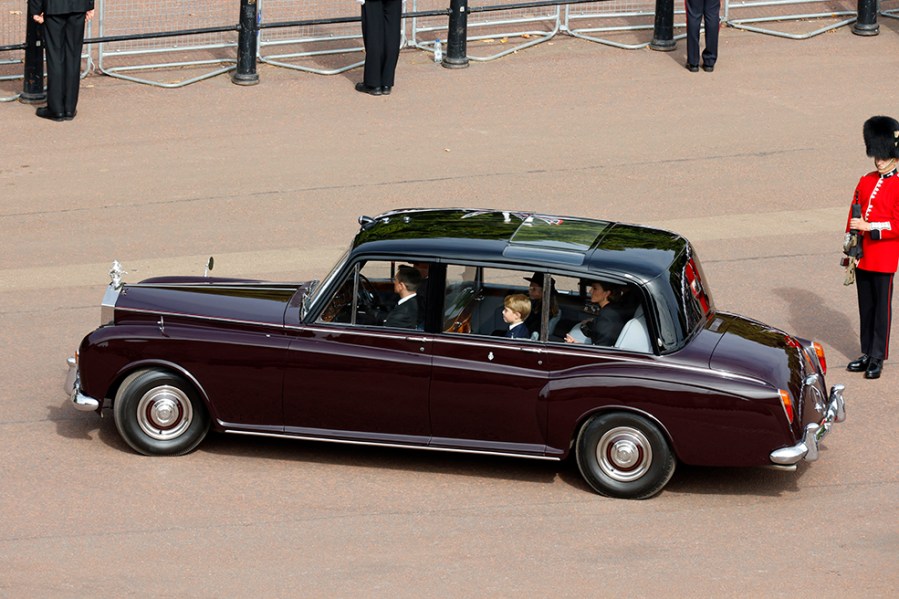
Prince George of Wales, Princess Charlotte of Wales and Catherine, Princess of Wales are driven in car along the Mall after the State Funeral of Queen Elizabeth II on September 19, 2022 (Photo by Chip Somodevilla/Getty Images)
The King’s ‘everyman’ cars
For our new King there has been a long association with more run-of-the-mill automobiles. Aged just two, Charles was presented with an Austin J40, one of the pedal cars made by the Austin Motor Company using metal offcuts from the Longbridge production line. In 1955 came the Rollalong Royal Caravan. The Hampshire-based firm created the wooden framed aluminium mini caravan for a young Prince Charles and Princess Anne, presented to them on behalf of the Caravan Club and towed by Prince Philip’s Hillman Husky. Today it is on display at the National Motor Museum in Beaulieu.
Alongside his first ‘proper’ car, the 1968 MGC GT, and the Aston Martins with which he is often associated, Charles inherited the family passion for Land Rover products. The monarch has been pictured driving various Range Rovers over the years; he used an Olive Green model while dating the-then Lady Diana Spencer. There is a famous image of Diana sitting on the bonnet of the car at the Grand National in 1982, at which time she was pregnant with Prince William.
In more recent years came a handful of further everyman models, used by the-then Prince of Wales for transport. In 1999 Charles was photographed by the paparazzi exiting the Ritz with Camilla Parker Bowles, our new Queen Consort. Camilla had arrived in a Ford Mondeo estate, while Charles was driving a Vauxhall Omega.
At the turn of the new millennium came a change of pace, with the British-built cars we had become accustomed to seeing the Royals drive began to be replaced by vehicles from German manufacturer, Audi. In 2002 came Charles’s Audi A6 Allroad, while in 2016 he hit a deer at Balmoral while driving an Audi A4. The first electric car in the household arrived when Charles leased a Loire-Blue Jaguar i-Pace in 2018. A charging point was installed at Clarence House, with this new battery-powered vehicle adding to the new King’s green credentials.
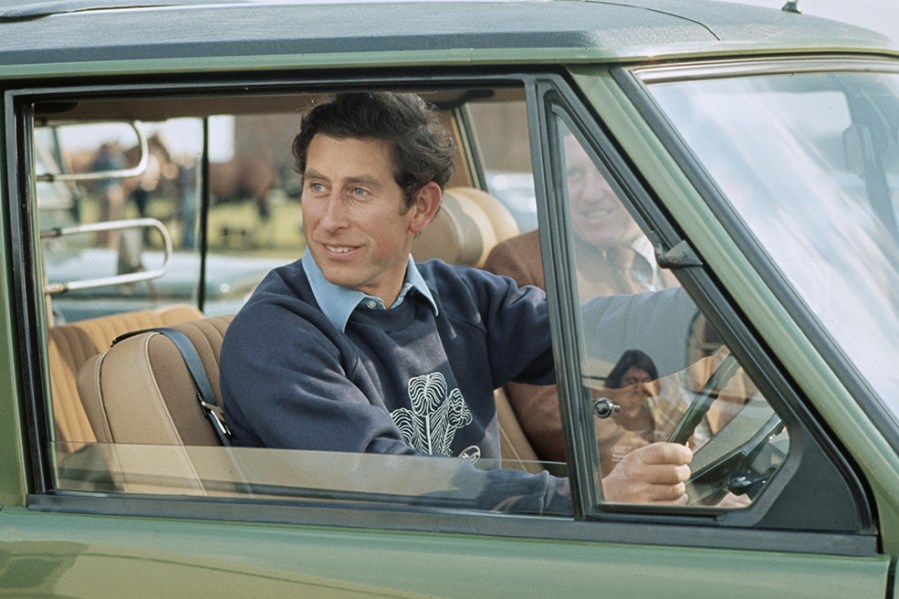
Charles in his Range Rover after polo at Windsor, circa 1978 (Photo by Tim Graham Photo Library via Getty Images)
Philip’s MG & Anne’s Reliants
Prince Philip was a keen car enthusiast, with a penchant for sports cars, particularly British-built vehicles. In the latter part of the 1940s, the late Duke of Edinburgh drove a black 1946 MG TC – HXD 99 – parting with it a couple of years later, replacing it with a TD model shortly before the death of his father-in-law, King George, in 1952. He’s also been pictured with a Reliant Scimitar GT.
We know that Philip’s adoration for British cars was passed to Charles, but it clearly resonated with other Royals too. Princess Anne has become synonymous with the Reliant Scimitar GTE; the Princess owned eight Scimitars, early examples with the 3.0-litre Essex V6 engine and later cars with the 2.8-litre Cologne unit. She is said to still be in possession of a 1989 Middlebridge example today.
Latterly, Prince Philip’s coffin was transported via a specially designed Land Rover Defender hearse during his funeral procession to St. George’s Chapel, Windsor Castle in 2021. The Land Rover Td5 Defender 130 Hearse was reportedly designed by the Duke of Edinburgh himself.
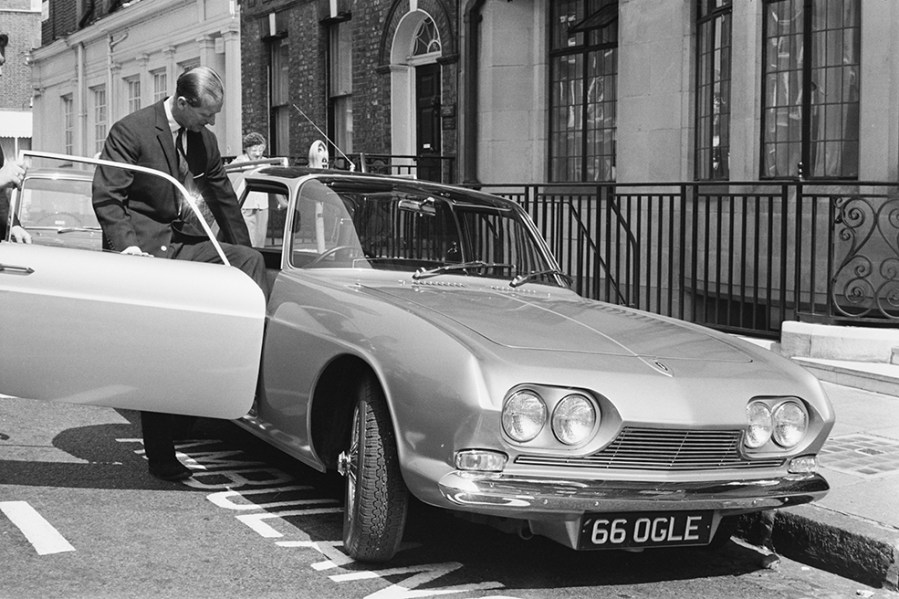
Prince Philip, Duke of Edinburgh with his new Reliant Scimitar during a visit to see Princess Anne at King Edward VII’s Hospital in London in 1966
Diana’s driving dynasty
Diana, Princess of Wales, drove a number of noteworthy cars, one of the first was a blue Renault 5, driven by an 18-year-old Ms Spencer. In 1980 the Austin Mini Metro was launched, the-then Prince Charles test drove one at the British Leyland factory, purchasing a £3495 Austin MiniMetro 1.0L – MPB 909W – shortly afterwards as a gift for Diana. She reportedly adored the little red car, driving it until June 1981 when it was sold. The Metro reemerged in the 1990s when it was sold for £6000, today it forms part of the collection at Coventry Transport Museum with around 30,000 miles having passed under its wheels.
A 1981 Ford Escort Ghia that was gifted by Charles as engagement present would be Diana’s next car, which she used until summer 1982. It was auctioned by Reeman Dansie, specialist royalty auctioneers in Colchester, in 2021, fetching an impressive £52,640. An Escort 1.6i Cabriolet was set to become Princess Diana’s second Escort, but it was deemed unsuitable by Royal security experts.
As a result came a brand-new Ford Escort RS Turbo, one of only three Series 1 cars painted black by Ford’s Special Vehicle Engineering department. A secondary rear-view mirror was fitted for the use of Diana’s protection officer, alongside a radio fitted into the glove box. First registered in August 1985, it was photographed extensively in London’s hot spots, such as Chelsea and Kensington. The Escort was returned to Ford in May 1988 having covered 6800 miles. It was later part of a giveaway by Kiss FM, entering a private collection in 2008. This car was famously sold by Silverstone Auctions for £722,500 in 2022.
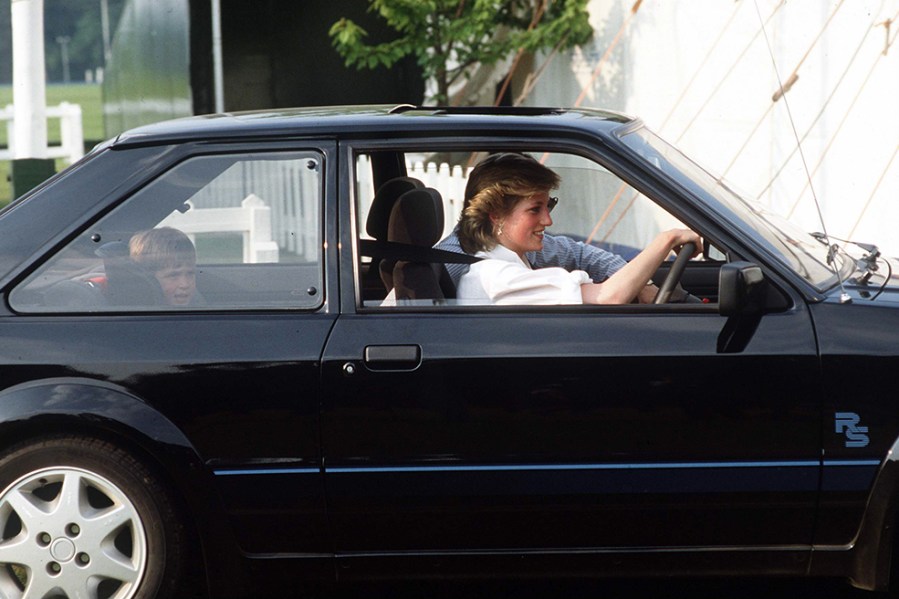
Princess Diana at the wheel of her Ford Escort RS Turbo with a young Prince William in tow (Photo by Tim Graham Photo Library via Getty Images)
In 1987, Diana took delivery of a British Racing Green Jaguar XJ-S Cabriolet V12. Usually offered as a pure two-seater, the XJ-SC was not very practical for transporting two young children – William and Harry – and so it was fitted with two small rear seats fit for a pair of Princes. The car was also equipped with a bespoke fixed rear hardtop to avoid injuries to the boys in the event of an accident, a unique mix of leather and Harris Tweed upholstery also appeared inside. The Duchess of York, Sarah Ferguson, also drove an early XJ-S convertible. Diana drove Prince William to boarding school in her XJ-S in September 1990, Charles turning up independently in his Aston – fuelling speculation that their marriage was on the rocks. Diana’s car was donated to the Jaguar Heritage Trust in 1991, where it is still kept.
Thought to be a response to the fact that her sons could no longer fit in the back of the Jaguar, the XJ-SC was ultimately replaced with a Mercedes-Benz 500SL. It was an interesting choice as it was the first time a member of the British Royal Family had driven a foreign car privately. Diana took delivery of the metallic red R129 in December 1991. However, she came under pressure from the government, and some believe the Palace itself over the car, and she returned it to Germany in September 1992. Today is resides in the Mercedes-Benz museum in Stuttgart.
In 1994 Princess Diana began driving an Audi 80 Cabriolet 2.3E. The Gomera Pearl example – L449 TRP – did much for the model’s image as a whole, with sales reportedly increasing two-fold as a result of the association with one of the world’s most famous women. Diana used the car to transport Princes William and Harry during their summer holidays in 1994, returning it in July that same year with just 4000 miles on its clock. The car subsequently ended up in private collections, sold at auction in 2017 for £58,000. It reappeared at auction again in May 2018, offered via Historics Auctioneers, but it failed to find a new home on that occasion.
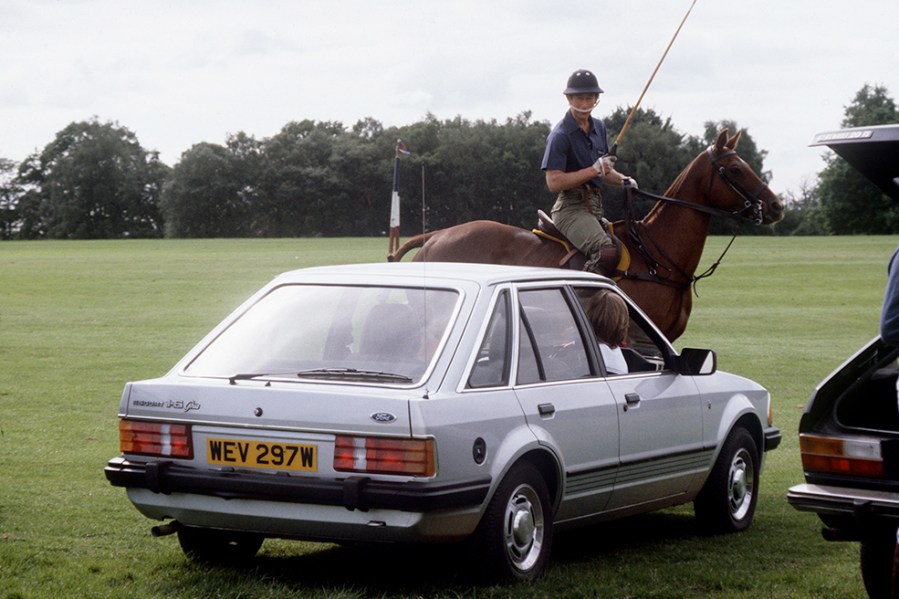
Then-Lady Diana Spencer in her Ford Escort Ghia watching then-Prince Charles playing polo at Windsor (Photo by Tim Graham Photo Library via Getty Images)
William’s wheels
Prince William began his driving career with a far more humble set of wheels than you might presume. A Mk1 Ford Focus, in fact. The future King was photographed at the wheel of a silver Ford Focus in 1999, following a driving lesson at the Highgrove Estate when he was just 17 years of age. William was clearly keen to get behind the wheel; he passed his written theory test just a day after his 17th birthday, progressing rapidly on to the practical side. He took a total of 20 lessons prior to passing his practical test at the first attempt.
Perhaps part of the reason why William was so keen to get out on the open road was the incentive awaiting him – his first car. While his father was given an Aston Martin at 21, William was gifted a sightly more mundane motor for his 17th birthday by Charles – a Volkswagen Golf Mk3. The Mk3 had already been replaced by the Mk4 when William was handed the keys to his, however it wasn’t too long before he landed himself in hot water while driving it, Lord Bathurst accusing the Prince of driving too fast on his estate near Cirencester.
According to reports at the time, William drove up behind Bathurst’s Land Rover on an unmade road before overtaking, a move replicated by the Prince’s close protection offers giving chase in the car behind. Bathurst rolled in hot pursuit blasting his horn in anger, at which point William’s security guards pulled him over before giving the Lord some stern advice.
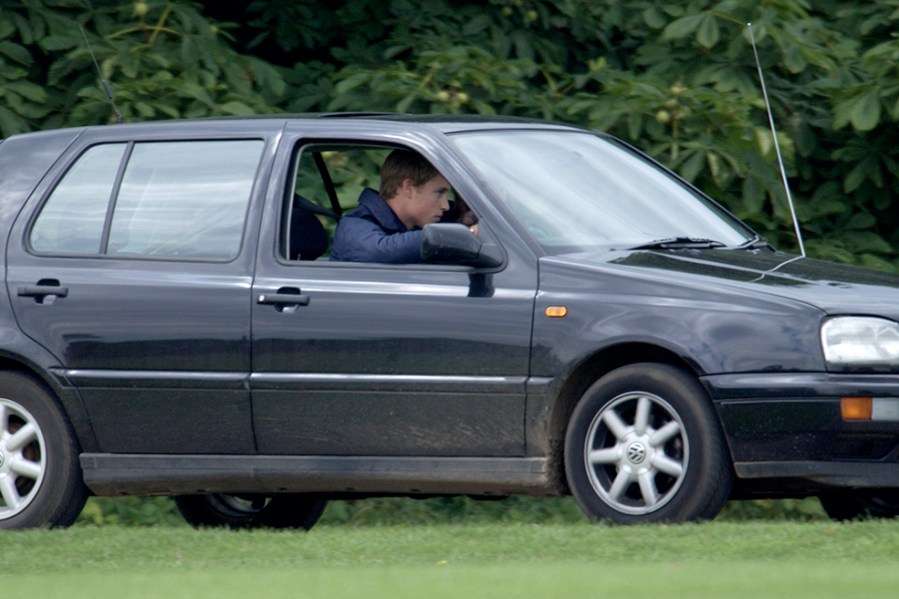
Prince William driving his Mk3 Volkswagen Golf at polo in Cirencester (Photo by Tim Graham Photo Library via Getty Images)
In more recent times William and his wife, Kate Middleton, now Princess of Wales, have been spotted in a variety of vehicles. Like his mother and father, William has an affinity with Audi, driving a range of its modern offerings. However, he also clearly has a passion for older cars, too. William and Kate borrowed the new monarch’s Aston Martin DB6 on their wedding day, William emerging at its wheel for a parade from Buckingham Palace to Clarence House. The car was decorated with balloons, red, white and blue ribbons and L-plates, while wearing a number plate that read ‘JU5T WED’.
Land Rovers have played a key part in William’s life, too, just as they have for his royal relations, William and Kate have been photographed driving in a Series III thought to have once belonged to Prince Philip. The couple were also first in the queue for the latest all-new Range Rover, taking delivery of the £100,000 vehicle before most other customers. Last year the pair were once again seen in a classic car during their tour of the Caribbean in celebration of the Queen’s Platinum Jubilee.
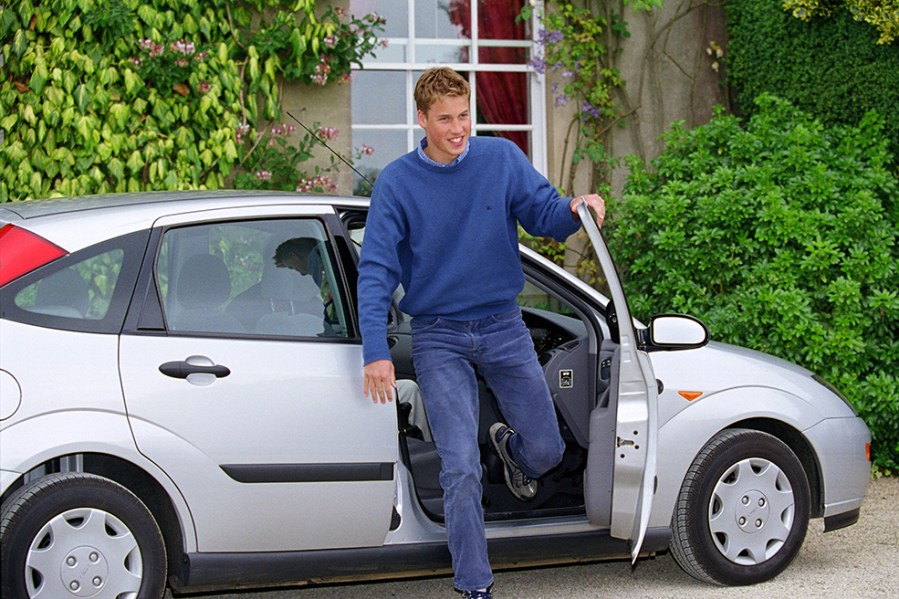
Learner-driver Prince William arrives at Highgrove in a Ford Focus in 1999 (Photo by Tim Graham Photo Library via Getty Images)

